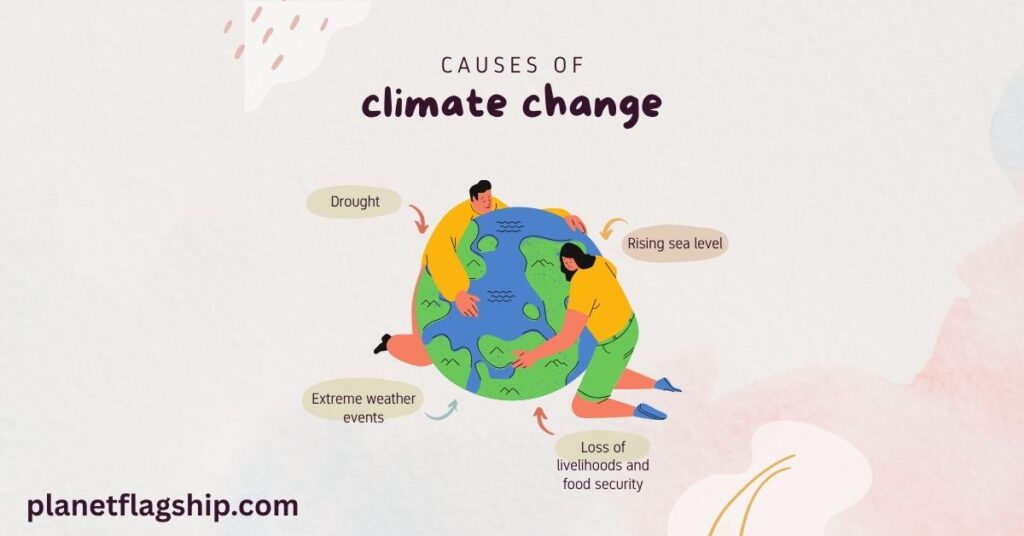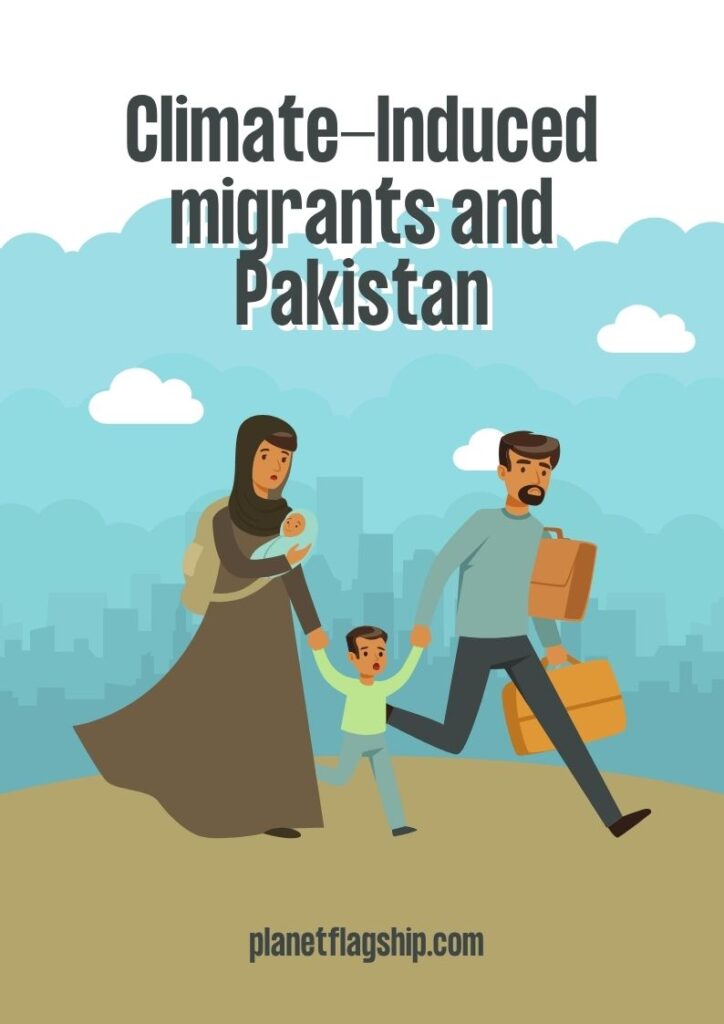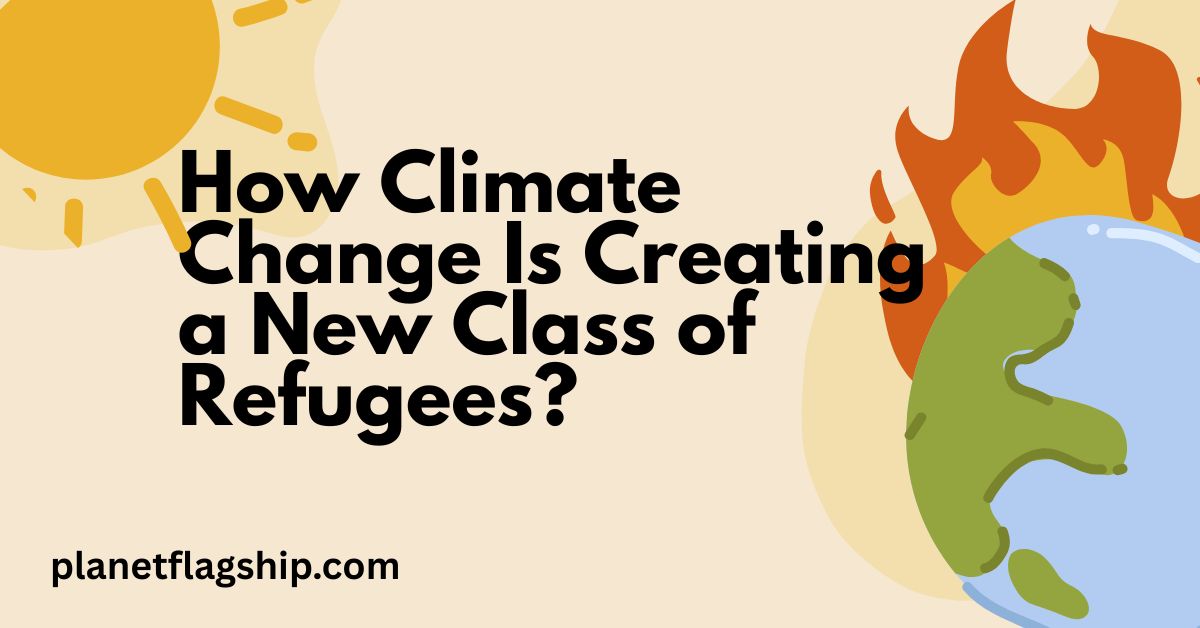Introduction
According to recent statistics from the Internal Displacement Monitoring Centre (IDMC), flooding, winds, and other natural disasters, including earthquakes and droughts, have displaced over 376 million people globally since 2008. Climate change is no longer some vague, distant threat. It is a crisis unfolding right before our eyes.
One of the most far-reaching and disturbing implications is the emergence of a new group of refugees and internally displaced people who are evacuating their places of origin due to climate-induced crises. Unlike traditional refugees fleeing war or persecution, these people are being displaced by their own goals of environmental changes, such as rising seas, extreme weather, prolonged drought, and the collapse of ecosystems.
From the Pacific islands to the arid savannahs of Africa and the high desert of North America, climate migrants are already on the move. The UNHCR’s 2024 report states that an average of 21.5 million people are displaced annually due to weather conditions that are expected to drastically increase.
This article primarily discusses the causes and reasons behind displacement, including climate displacement, its global and local impacts, policy challenges faced by refugees, and recommendations for mitigating this crisis (UNHCR, 2024).
Climate Refugee
A “climate refugee” refers to individuals who are compelled to leave their homes temporarily or permanently, within or outside their country, due to sudden or gradual changes to their local environment resulting from climate change. According to European Parliamentary Research Service (EPRS) records, 32.6 million people were displaced in 2022.
There is an annual increase in the total number of displaced people due to disasters, compared to an average of 43% in the previous decade, with an alarming trend that is becoming increasingly apparent. With climate change as a driving force, the number of ‘climate refugees’ will continue to increase. The worst-case scenario would see 1.2 billion people displaced by 2050 due to natural disasters and ecological threats (WorldBank, 2021).
Climate change effects could range from sea level rise to desertification, cyclone flooding, drought, hurricanes, or wildfires.
According to the International Organization for Migration, there are three types of environmental migrants:
- Environmental emergency migrants: Individuals compelled to relocate due to the sudden or gradual onset of an environmental disaster.
- Environmentally displaced people: individuals who cannot stay in their homes due to a worsening environment, such as deforestation, coastal deterioration, and the submergence of coastal areas caused by sea level rise.
- Environmentally motivated migrants (also referred to as ecologically induced economic migrants) are individuals who decide to leave in the future due to environmental degradation, such as those who depart because their crops are less productive because of desertification.
Floods, droughts, and other climate-related issues are forcing many people from their homes. But that is not how international law regards them as “refugees,” ultimately because the current definition extends protection only to those who flee war or persecution based on conditions such as race or religion.
Climate refugees lack the same rights and legal protections as traditional refugees, despite having no choice but to relocate. And as climate change intensifies, more people are falling into this legal gap without recourse (McEldowney & Drolet, 2021).
Causes of Climate-Induced Refugee

The following section describes the four main causes of climate-induced displacement:
- Drought and desertification
- Rising sea level
- Extreme weather events
- Loss of livelihoods and food security
Drought and Desertification
The prolonged droughts and expansion of desert-like conditions, or desertification, are causing a process of slow-onset displacement in many regions of the world. Desertification has swept across sub-Saharan Africa’s Sahel, driving pastoralists and farmers off their land. In Syria, a prolonged drought from 2006 to 2010 resulted in the loss of 75% of crops and led to the migration of rural villagers to urban areas, thereby intensifying social pressures and escalating civil unrest.
In India, for example, in regions such as Maharashtra, the ongoing drought is driving thousands of farmers to migrate to cities every year in search of alternative employment opportunities. Droughts affect not only the availability of food and water but also access to education and healthcare, leading to intricate, multi-generational cycles of poverty and migration.
Rising Sea Level
One of the most visible effects of climate change is the rise in sea levels, which also has a destructive impact on the world. Due to rising temperatures, the world’s glaciers and polar ice sheets are melting, leading to increased sea levels and a significant threat to the oceans. This result indicates that small islands in coastal areas, which impact the habitats of coastal cities in Indonesia and Bangladesh, are experiencing severe seasonal flooding that contaminates their freshwater resources and displaces millions of people.
Sea level rise is also a significant threat to island nations like the Maldives, Kiribati, and Tuvalu, which are not only affecting their land but also their culture and sovereignty. In fact, Kiribati has purchased land in Fiji for future generations, in case their habitat is affected by sea level rise.
The Intergovernmental Panel on Climate Change (IPCC) has depicted that since 1900, sea levels have risen by up to 3.3 mm. Low emissions are predicted to result in a 3- to 6-foot rise in global sea levels by 2100 (IPCC, 2021).
Extreme Weather Events
Since the large drivers of change are global, the extreme weather events that have been uncommonly severe and frequent over recent years can be attributed to climate change. Hurricanes, typhoons, cyclones, and floods displace millions of people every year. In 2020 alone, 30.7 million people were displaced by weather-related disasters. Cyclone Idai hit Mozambique, Zimbabwe, and Malawi in 2019, affecting over 400,000 people and destroying entire villages.
Hurricanes such as Harvey (2017) and Ian (2022) displaced hundreds of thousands in the United States, demonstrating that high-income countries also experience the impact. These are disasters that not only ravage infrastructure and homes but also leave many in a state of perpetual economic instability in the aftermath, making their return or recovery almost impossible.
READ MORE: https://planetflagship.com/
Loss of Livelihood and Food Security
Climate change is wreaking havoc on ecosystems and disrupting the lives of people who depend on natural resources.
- Fishermen watch as their fish stocks vanish due to warm and acidic oceans.
- Farmers face unseasonable growing conditions; pests and infestations, as well as eroded soil, result in lower yields.
- In South and Southeast Asia, the monsoon cycle has shifted, leaving rice and wheat production to suffer as a result.
A World Bank report warned that more than 140 million people in sub-Saharan Africa and South Asia, along with Latin America, could face internal displacement by 2050. This is a result of declining water availability, crop failure, and rising temperatures (Apap & Harju, 2023).
Regions at most risk
- South Asia is one of the most vulnerable regions due to its high population, poverty, and dependence on agriculture for its economy. Bangladesh, with 700 rivers, faces riverbank erosion due to rising sea levels, which displace approximately 500,000 people annually. According to the World Bank, 13.3 million Bangladeshis could be displaced by 2050 as a result of climate change.
- The Pacific Islands are already considering relocation due to the increasing issue of salinization in their soil and freshwater resources. Most people migrate to New Zealand and Australia through legal or illegal means.
- In Africa, people are facing both political instability and climate change. In Nigeria, communities frequently clash over land and water resources. In Ethiopia and Somalia, famine and desertification are pushing people to migrate either to cities or across the border.
- Even developed nations like the United States are facing climate-induced migration. Midwest floods, California wildfires, and Southeastern hurricanes are driving internal migration. Due to the melting of permafrost, which leads to sea level rise, Alaskan Indigenous communities are planning to relocate (UNHCR, 2024).
Climate-Induced migrants and Pakistan

- Pakistan faced 107 disaster events, including floods, from 2008 to 2022, which led to the displacement of 23.6 million people within the country.
- Due to climate-induced hardships, Karachi is expected to receive an additional 2.3 million people by 2050.
- One million people living around the Indus Delta face challenges due to the rise in sea level and the intrusion of salinity.
- In Sindh and Balochistan, people are experiencing a prolonged drought that causes agricultural and water-related issues, prompting them to migrate.
Flood and Drought Impacts in Pakistan
| Year | Disaster Type | People Affected | Fatalities | Notable Details |
| 2010 | Flood | ~20 million | ~2,000 | Extensive infrastructure and agricultural damage, 1.6 million displaced |
| 2022 | Flood | 33 million | 1700 | $40 billion in damages; over 2.1 million displaced |
| 2024 | Flood | ~551,100 | — | Significant impact in Balochistan and Sindh provinces |
| 1998–2002 | Drought | ~3 million | — | One of the worst droughts in history |
| 2019 | Drought | ~4.8 million | — | Severe conditions in Sindh and Balochistan |
| 2021–2022 | Drought | ~500,000 | — | Crisis-level food insecurity |
Gaps in legal policies
- There is no legal status for climate-induced refugees.
- The Global Compact for Migration and the Platform on Disaster Displacement are working to improve international coordination.
- There is an inconsistency in the national-level responses.
Requirements
- There is a need to recognize Climate-induced refugees legally
- There should be investment in climate adaptation measures, such as early warning systems, strong infrastructure, and disaster preparedness.
- There is a need to introduce migration pathways for climate-affected refugees and provide support and funding for the hosting regions.
- Mitigation efforts are necessary to mitigate climate change and reduce greenhouse gas emissions.
- Communicate the reality of refugees through awareness campaigns and education (McEldowney & Drolet, 2021).
FAQs: How Climate Change Is Creating a New Class of Refugees?
What exactly is a climate refugee?
A climate refugee is someone forced to leave their home due to environmental changes like floods, rising sea levels, or droughts caused by climate change. They often lack legal recognition and protection under international law.
Why are climate refugees increasing each year?
Extreme weather, long-term droughts, and rising seas are worsening due to climate change. These changes are damaging homes, livelihoods, and access to food and water—pushing more people to migrate.
Which areas are most affected by climate displacement?
Regions like South Asia, Pacific Islands, Sub-Saharan Africa, and parts of the U.S. are heavily impacted. For example, Bangladesh faces massive river flooding, and Pacific Island nations risk losing entire landmasses to sea rise.
How is Pakistan affected by climate-driven migration?
From 2008 to 2022, disasters displaced over 23 million people in Pakistan. Areas like Karachi and the Indus Delta are under pressure due to floods, droughts, and rising sea levels forcing people to move inland.
What can be done to protect climate refugees?
Governments must recognize climate refugees legally, build climate-resilient infrastructure, and offer safe migration routes. On a personal level, reducing emissions and supporting eco-friendly policies can help slow climate impacts.
Conclusion
Climate change is one of the major issues affecting the world, impacting the environment, and changing the way people live. Rising sea levels and floods are affecting houses, while storms and violent weather conditions are damaging crops. As a result, people are forced to leave their homes in search of better survival, safety, and food security. The new class of refugees was created due to the growing crisis of climate change; despite their difficult times, they face legal and policy cracks.
By implementing laws and policies for climate-induced refugees, investing in emission reduction, and investing in climate adaptation, we can improve the current situation. Civil society can also play a more significant role in supporting and protecting refugees. At the individual level, we can play a crucial role in reducing emissions and adapting to climate change by conserving energy, minimizing waste, and supporting environmentally friendly policies.
Climate displacement actually tells about the severity of climate change. At each number of displacements, there is a family, culture, and community struggling to survive. If people act sensibly and compassionately, the environment can be protected, and a better, more resilient future can be created for all.
References:
UNHCR. (2024, November 12). HoThe effects of climate change on refugees and displaced communities are significant.etrieved from https://www.unrefugees.org/news/how-climate-change-impacts-refugees-and-displaced-communities/#HowisUNHCRaddressingclimatechangeanddisasterdisplacement?
World Bank. (2021, September 13). Climate Change Could Force 216 Million People to Migrate to Their Own Countries by 2050. Retrieved from https://www.worldbank.org/en/news/press-release/2021/09/13/climate-change-could-force-216-million-people-to-migrate-within-their-own-countries-by-2050
- Apap, J., & Harju, S. (2023). The Concept of “Climate Refugee”: Towards a Possible Definition. European Parliament, October. https://www.europarl.europa.eu/RegData/etudes/BRIE/2021/698753/EPRS_BRI(2021)698753_EN.pdf
- IPCC. (2021). The topic of discussion is migration and climate change. Futuribles: Analyse et Prospective, 341. https://doi.org/10.1051/futur:200834131
- McEldowney, J. F., & Drolet, J. L. (2021). The study delves into the relationship between climate change and refugees. The Impacts of Climate Change: A Comprehensive Study of Physical, Biophysical, Social, and Political Issues, 537–545. https://doi.org/10.1016/B978-0-12-822373-4.00010-0

John is a professional blogger and passionate advocate for environmental sustainability. With years of experience exploring eco-friendly practices and green innovations, he shares insightful articles on Planet Flagship to inspire a sustainable future. John’s expertise lies in making complex environmental topics accessible and actionable, empowering readers to make meaningful changes for the planet.
